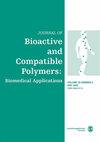埃塞俄比亚本土传统药用植物巴豆叶提取物负载 PCL 电纺纳米纤维垫,可作为潜在的伤口敷料:体外分析
IF 2.2
4区 生物学
Q3 BIOTECHNOLOGY & APPLIED MICROBIOLOGY
引用次数: 0
摘要
本研究的主要目的是首次通过电纺丝技术研究埃塞俄比亚本土药用植物克罗顿(Croton macrostachyus)在 PCL 纳米纤维中的潜在应用。Croton macrostachyus(CM)叶片具有抗菌和伤口愈合特性。通过电纺丝技术制备了含 1%、3%、5% 和 7% (重量/体积比)巴豆叶的 PCL 纳米纤维毡。用扫描电子显微镜(SEM)观察所制得的纳米纤维垫,发现其形态连续、无珠状物且相互连接。PCL、PCL-1%CM、PCL-3%CM、PCL-5%CM 和 PCL-7%CM 纳米纤维毡的平均直径分别为 309 ± 114、271 ± 66、235 ± 56、226 ± 65 和 216 ± 42 nm。傅立叶变换红外光谱结果表明,中药叶提取物成功地融入了 PCL 纳米纤维。PCL-1%CM、PCL-3%CM、PCL-5%CM 和 PCL-7%CM 纳米纤维毡对金黄色葡萄球菌的抑菌率分别为 77.00%、99.88%、99.91% 和 99.99%,对大肠杆菌的抑菌率分别为 35.00%、78.00%、90.00% 和 99.30%。体外释放研究表明,在 1%、3%、5% 和 7% 的浓度下,中药在 24 小时内立即释放,然后在 72 小时内稳定持续释放,释放量分别为 51.36%、53.92%、54.99% 和 57.12%。PCL纳米纤维中含有CM叶提取物增加了纯PCL纳米纤维的亲水性(叶提取物浓度为7%时亲水性为100%)。总之,体外研究结果证实,添加了中药叶提取物的 PCL 纳米纤维毡适合用作具有广谱抗菌活性和亲水性能的有效伤口敷料。本文章由计算机程序翻译,如有差异,请以英文原文为准。
Indigenous Ethiopian traditional medicinal plant leaf extract, Croton macrostachyus, loaded PCL electrospun nanofibrous mat as potential wound dressing: In vitro analysis
The main aim of this study was to investigate the potential application of an indiginous Ethiopian medicinal plant, Croton macrostachyus, into PCL nanofibers through electrospinning for the first time. Croton macrostachyus (CM) leaf has antibacterial and wound healing properties. Croton macrostachyus of 1%, 3%, 5%, and 7% (w/v) incorporated PCL nanofibrous mats were produced through electrospinning. The produced nanofibrous mats morphology observed by scanning electron microscopy (SEM) was found to be continuous, bead-free, and interconnected. The average diameters of PCL, PCL-1%CM, PCL-3%CM, PCL-5%CM, and PCL-7%CM nanofibrous mat is 309 ± 114, 271 ± 66, 235 ± 56, 226 ± 65, and 216 ± 42 nm, respectively. According to the FTIR results, the CM leaf extract was successfully incorporated into the PCL nanofibers. The bacterial reduction percentage value of PCL-1%CM, PCL-3%CM, PCL-5%CM, and PCL-7%CM nanofiber mats against S. aureus is 77.00%, 99.88%, 99.91%, and 99.99%, and 35.00%, 78.00%, 90.00%, and 99.30% against E. coli. The in vitro release study showed that there was an immediate release of CM within 24 h and then a steady sustained release of 51.36, 53.92, 54.99, and 57.12% up to 72 h at 1%, 3%, 5%, and 7% concentration, respectively. The presence of CM leaf extract in the PCL nanofiber increased the hydrophilicity of the pure PCL nanofiber (100% hydrophilic at 7% leaf extract concentration). In general, the results of the in vitro study confirmed that the PCL nanofibrous mats loaded with CM leaf extract are suitable for use as an effective wound dressing with a broad spectrum of antimicrobial activity and hydrophilic properties.
求助全文
通过发布文献求助,成功后即可免费获取论文全文。
去求助
来源期刊

Journal of Bioactive and Compatible Polymers
工程技术-材料科学:生物材料
CiteScore
3.50
自引率
0.00%
发文量
27
审稿时长
2 months
期刊介绍:
The use and importance of biomedical polymers, especially in pharmacology, is growing rapidly. The Journal of Bioactive and Compatible Polymers is a fully peer-reviewed scholarly journal that provides biomedical polymer scientists and researchers with new information on important advances in this field. Examples of specific areas of interest to the journal include: polymeric drugs and drug design; polymeric functionalization and structures related to biological activity or compatibility; natural polymer modification to achieve specific biological activity or compatibility; enzyme modelling by polymers; membranes for biological use; liposome stabilization and cell modeling. This journal is a member of the Committee on Publication Ethics (COPE).
 求助内容:
求助内容: 应助结果提醒方式:
应助结果提醒方式:


